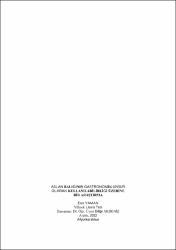Aslan balığının gastronomik unsur olarak kullanılabilirliği üzerine bir araştırma
Özet
İstilacı yabancı türler, dünya çapında pek çok olumsuz ekolojik, sosyal ve ekonomik etkiye sebep olmaktadır. Bu nedenle istilacı türlerin yayılımının kontrol edilmesi için geliştirilen stretejiler oldukça önemlidir. Bu statejilerden biri de istilacı türlerin, gıda ürünü olarak kullanılmasıdır. Bu çalışmanın amacı ise, istilacı bir tür olarak kabul edilen ve zehirli olarak bilinen aslan balığının, gastronomik bir unsur olarak kullanılabilirliğine yönelik mutfak şeflerinin düşüncelerinin derlenmesidir. Bu amaç doğrultusunda görüşme yöntemi ve deneysel yöntem olmak üzere iki farklı araştırma yöntemi kullanılmıştır. Öncelikle, yarı yapılandırılmış görüşme formu kullanılarak veriler toplanmıştır. Araştırma kapsamında Türkiye genelinde menülerinde aslan balığınına yer veren veya belirli bir süre yer vermiş olan on mutfak şefiyle çevrimiçi veya yüz yüze görüşmeler yapılarak veriler elde edilmiştir. Elde edilen veriler betimsel analiz yöntemiyle ile çözümlenmiştir. Görüşmelerden elde edilen veriler doğrultusunda restoran menülerinde kullanılabilecek şekilde hazırlanmış dört farklı aslan balığı tarifi geliştirilmiş ve eğitimli panelistlerle duyusal analizler gerçekleştirilmiştir. Sonuç olarak aslan balığının bir gastronomik unsur olarak kullanılabilir olduğu ve mutfak şeflerinin aslan balığını kullanmaya istekli oldukları görülmüştür. Bu çalışmanın gelecekte yapılacak olan benzer çalışmalara yarar sağlayacağı düşülmektedir. İnvasive alien species may cause many negative ecological, social, and economic impacts worldwide. Therefore, strategies developed to control the spread of invasive species are very important. One of these strategies is the use of invasive species as food crops. This study aims to compile the thoughts of kitchen chefs on the use of lionfish, considered an invasive species known as poisonous, as a gastronomic element. For this purpose, two different research methods were used: the interview and experimental methods. First of all, data were collected using a semi-structured interview form. Within the scope of the research, data were obtained through the internet or face-to-face interviews with ten kitchen chefs who included lionfish in their menus or included them for a certain period. The obtained data were analyzed with the descriptive analysis method. İn line with the data obtained from the interviews, four different lionfish recipes were developed to be used in restaurant menus. Sensory analyzes were performed with trained panelists for the developed lionfish recipes. As a result, it has been seen that lionfish can be used as a gastronomic element in our country and kitchen chefs are willing to use lionfish. İt is thought that this study will benefit similar studies in the future.
Bağlantı
https://hdl.handle.net/11630/10268Koleksiyonlar
- Yüksek Lisans Tezleri [1639]



















